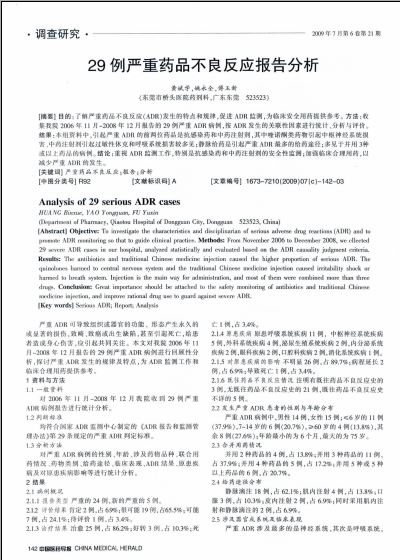29例严重药品不良反应报告分析(1)
 |
| 第1页 |
参见附件(1917KB,3页)。
[摘要] 目的:了解严重药品不良反应(ADR)发生的特点和规律,促进ADR监测,为临床安全用药提供参考。方法:收集我院2006年11月~2008年12月报告的29例严重ADR病例,按ADR发生的关联性因素进行统计、分析与评价。结果:本组资料中,引起严重ADR的前两位药品是抗感染药和中药注射剂,其中喹诺酮类药物引起中枢神经系统损害、中药注射剂引起过敏性休克和呼吸系统损害较多见;静脉给药是引起严重ADR最多的给药途径;多见于并用3种或以上药品的病例。结论:重视ADR监测工作,特别是抗感染药和中药注射剂的安全性监测;加强临床合理用药,以减少严重ADR的发生。
[关键词] 严重药品不良反应;报告;分析
[中图分类号] R92 [文献标识码] A[文章编号]1673-7210(2009)07(c)-142-03
Analysis of 29 serious ADR cases
HUANG Binxue, YAO Yongquan, FU Yuxin
(Department of Pharmacy, Qiaotou Hospital of Dongguan City, Dongguan 523523, China)
[Abstract] Objective: To investigate the characteristics and disciplinarian of serious adverse drug reactions (ADR) and to promote ADR monitoring so that to guide clinical practice. Methods: From November 2006 to December 2008, we cllected 29 severe ADR cases in our hospital, analyzed statistically and evaluated based on the ADR causality judgment criteria. Results: The antibiotics and traditional Chinese medicine injection caused the higher proportion of serious ADR. The quinolones harmed to central nervous system and the traditional Chinese medicine injection caused irritability shock or harmed to breath system. Injection is the main way for administration, and most of them were combined more than three drugs. Conclusion: Great importance should be attached to the safety monitoring of antibiotics and traditional Chinese medicine injection, and improve rational drug use to guard against severe ADR.
[Key words] Serious ADR; Report; Analysis
严重ADR可导致组织或器官的功能、形态产生永久的或显著的损伤,致畸、致癌或出生缺陷,甚至引起死亡,给患者造成身心伤害,应引起共同关注。本文对我院2006年11月~2008年12月报告的29例严重ADR病例进行回顾性分析,探讨严重ADR发生的规律及特点,为ADR监测工作和临床合理用药提供参考。
1 资料与方法
1.1 一般资料
对2006年11月~2008年12月我院收到29例严重ADR病例报告进行统计分析。
1.2判断标准
均符合国家ADR监测中心制定的《ADR报告和监测管理办法》第29条规定的严重ADR判定标准。
1.3分析方法
对严重ADR病例的性别、年龄、涉及药物品种、联合用药情况、药物类别、给药途径、临床表现、ADR结果、原患疾病及对原患疾病影响等进行统计分析。
2 结果
2.1 病例概况
2.1.1 报告类型 严重的24例,新的严重的5例。
2.1.2评价结果 肯定2例,占6.9%;很可能19例,占65.5%;可能7例,占24.1%;待评价1例,占3.4%。
2.1.3治疗结果 治愈25例,占86.2%;好转3例,占10.3%;死亡1例,占3.4%。
2.1.4 原患疾病 原患呼吸系统疾病11例,中枢神经系统疾病5例,外科系统疾病4例,泌尿生殖系统疾病2例,内分泌系统疾病2例,眼科疾病2例,口腔科疾病2例,消化系统疾病1例。
2.1.5 对原患疾病的影响 不明显26例,占89 ......
您现在查看是摘要介绍页,详见PDF附件(1917KB,3页)。